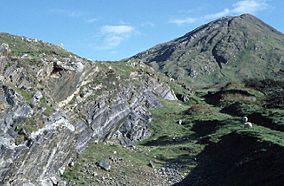Connemara National Park facts for kids
Quick facts for kids Connemara National Park |
|
|---|---|
|
IUCN Category II (National Park)
|
|

Diamond Hill in Connemara National Park
|
|
| Location | Letterfrack, Ireland |
| Area | 2957 ha |
| Established | 1980 |
| Governing body | National Parks and Wildlife Service (Ireland) |
Connemara National Park is a beautiful natural area in Letterfrack, Ireland. It opened to visitors in 1980. This park covers a huge area of 2,957 hectares. That's like 7,300 football fields! You can find mountains, wet bogs, open heaths, green grasslands, and thick forests here. The main entrance is near Letterfrack, on the way to Clifden.
The park isn't just about nature. It also holds clues about people who lived there long ago. You can see an old graveyard from the 1800s. There are even 4,000-year-old stone tombs called megalithic court tombs. A lot of the land in the park used to belong to the famous Kylemore Abbey estate.
Contents
Exploring Connemara's Nature
Connemara National Park is a special place for plants and animals. It's home to many different types of habitats. These include mountains, bogs, and woodlands.
Amazing Plants of Connemara
The most common plants you'll see are found in the blanket bog and heathland areas. Bogs are very wet, low-lying places. Blanket bogs are found higher up, in drier mountain areas.
One of the most common plants is purple moorgrass. It creates colorful views across the landscape. The park also has some amazing carnivorous plants. These plants eat insects because the bog soil doesn't have many nutrients. The most common ones are sundew and butterworts trap.
Other plants you might spot include lousewort, bog cotton, milkwort, and bog asphodel. You can also find different kinds of orchids and bog myrtle. Plus, there are many types of lichens and mosses growing everywhere.
Wildlife in Connemara Park
Connemara National Park is famous for its many different birds. You can hear the songs of meadow pipits, skylarks, European stonechats, and common chaffinches. Other small birds like European robins and Eurasian wrens are also common.
Birds of prey, which hunt other animals, also live here. These include the common kestrel and Eurasian sparrowhawk. Sometimes, you might even see a merlin or a peregrine falcon.
In winter, more birds come to Connemara. These include woodcock, common snipe, common starling, song thrush, and mistle thrush. You might also see redwing and fieldfare.
It can be a bit harder to spot mammals, but they are definitely there! Fieldmice are common in the wooded areas. In the boglands, you might see rabbits, foxes, stoats, and shrews. At night, bats fly around.
Red deer used to live in Connemara a long time ago. They disappeared from the area about 150 years ago. But now, there's a group of red deer living in the park again. The largest mammal you'll see regularly in the park today is the famous Connemara pony.
See also
 In Spanish: Parque nacional de Connemara para niños
In Spanish: Parque nacional de Connemara para niños

